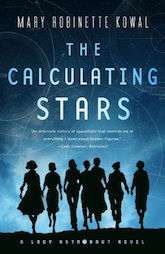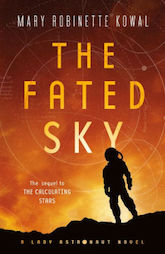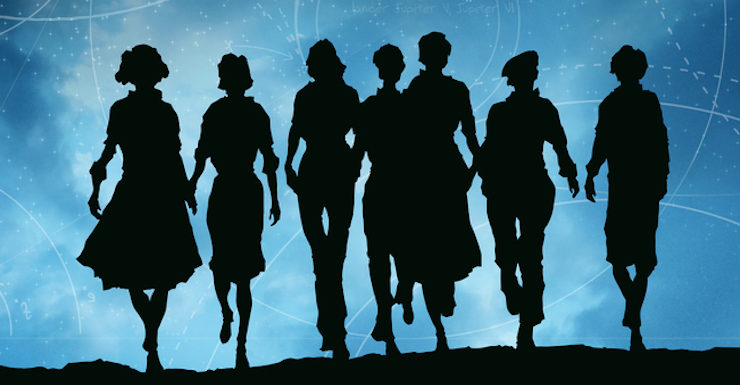It’s no secret that I’m an immense Mary Robinette Kowal fan. Just check out my review of Ghost Talkers. But it’s not just her fiction that impresses me, but also her kindliness, generosity, and willingness to share knowledge with the rest of the writing community through her blog, Twitter, and as part of the Writing Excuses crew.
In the immediate aftermath of the 2014 Hugo Awards ceremony, Kowal was kind enough to take me and another fellow winner under her wing, guiding us through the craziness that followed. She was basking in her own victory that night, but also took the time to give her time and attention to others that needed it.
That night, Kowal won the Hugo Award for Best Novelette for “The Lady Astronaut of Mars.” It’s the story of Elma, the titular Lady Astronaut of Mars, and follows her during her twilight years as she has to decide between staying with her terminally ill husband who barely recognizes her and returning to space, which remains her dream. In my review, I said:
Kowal has the ability to imbue her stories with rich life, to tug on the reader’s empathetic heartstrings while still challenging them to consider the many themes that run like tendrils between the lines of the narrative. “The Lady Astronaut of Mars” is at once charming and heartbreaking, tragic and hopeful. The greatest stories are layered and nuanced, and Kowal continues to prove that she’s a master at painting life onto science fiction’s limitless canvas, and creating universes that beg to be explored—all within the tight limitations of short fiction. “The Lady Astronaut of Mars” is a masterpiece of character, and a rich experience that begs to be read over and over again.
“The Lady Astronaut of Mars” is one of my all-time favourite pieces of short fiction, so to say I was excited when Kowal announced a pair of prequel novels would be an extreme understatement. “The Lady Astronaut of Mars” introduced us to Elma York near the end of her life, and Kowal used this framing device to hint at the tumultuous, fascinating conflicts and challenges that led Elma to become the famed Lady Astronaut. The novelette was so rich and full of promise that it begged to be expanded upon. The first of the Lady Astronaut prequels is The Calculating Stars, and it starts right at the beginning of Elma’s great adventure.
Buy the Book


The Calculating Stars
In fact, it starts off with a bang.
A huge bang.
In a pulse-pounding first act worthy of a summer blockbuster, The Calculating Stars opens in 1952 as a meteor collides with Earth, devastating the eastern United States seaboard, and instigating a period of intense climate change. This results in the best (remaining) scientists in the world fast-tracking human colonization of the moon, with Elma and her husband Nathaniel thrust right into the middle of it. Above and beyond the escape from the apocalyptic global warming, The Calculating Stars is also an examination of how people and nations respond to crisis. There’s a bit of a bait-and-switch about 20 percent of the way through the novel, when there’s a four year time jump, and the conflict switches from “imminent survival” to “the political challenges of getting people to space,” but, once you settle in, the novel’s majority storyline of getting to the moon becomes thrilling in its own right.
It seems almost too obvious to recommend The Calculating Stars to anyone who enjoyed Hidden Figures, but the similarities and strengths are striking. They’re both stories about sending humans to space, rife with well-considered and striking socio-political themes, including racism and sexism, and they excel on the strength of their ensemble cast. I’m a huge fan of Hidden Figures, so taking that general idea, ratcheting up the action and stakes, and expanding it into not one but two novels (a direct sequel is coming next month) is right up my alley. Like Hidden Figures, The Calculating Stars is about breaking down social barriers, and about marginalized people joining together to not only overcome conflict but to push humanity as a whole forward. It’s no surprise given Kowal’s pedigree, but these themes of overcoming adversity and breaking apart prejudices are well executed and vitally important.
That’s not to say that The Calculating Stars’ only, or even brightest, virtues are all tied up in its themes. Like Hidden Figures, and like the novelette that spawned it, The Calculating Stars is full of warm-hearted moments and generous humour. The end of the world is no laughing matter, but Kowal knows well the importance of levity, and the healing power of a laugh. One of my favourite moments came midway through the novel, when Elma is discussing the flight club she has formed with several other local women. “The first rule of flight club was—well, actually, the first rule was ‘safety,'” Elma explains to the reader. It’s a small moment, a little laugh, but it comes at exactly the right moment, while also providing both character insight and plot relevancy. Humour is not Kowal’s only mode, however—like all of her work, there’s a genuine thread of empathy woven throughout The Calculating Stars‘ tapestry. As mentioned earlier, the breaking down of societal and racial prejudices is and important theme in The Calculating Stars, and, at one point, Elma must seek help from the women in the Kansas City Negro Aeronautics Club (which is separate and segregated from Elma’s club). She approaches them naively, but in good faith, only to find herself the target of prejudice and discrimination. Instead of falling back defensively or angrily retorting, Elma reaches within herself, and, through humility and empathy, finds the strength and clarity she needs to build a bridge.
Miss Coleman stood. “I’ve got better things to do with my time than help another white lady exploit us.”
“Exploit?” I stood too. “Now, see here. I’m inviting you to fly, not to mop the floors or serve dinner.”
She smirked. “See? That’s the only way she can see us. I’m a mathematician and a chemist, working in pharmacy, but all you could think of were servant roles for me. So, no thank you, ma’am. You can just go on an convince yourself that you’re trying to save us. It’ll be without me.”
She strode off, leaving me gaping and with my skin too hot. I’d probably gone bright red with anger and embarrassment. I should have known better. I’d made the same mistake with Myrtle when we first moved in and I assumed she was just a housewife. She’d been a computer for a black business that had manufactured hair-straightening chemicals. I hadn’t even known such things existed.
“I’m a fool … Would you please convey my apologies? She’s absolutely right.” I gathered up my purse and started to pull my gloves back on. “Thank you for your time.”
“Did you say there was formation flying?” Miss Peaks started after Miss Coleman.
I stopped with one glove half-on. “Yes.” I didn’t say If we get the planes, but I thought it.
“And when’s the first practice?”
“I—does this mean you’re still willing to fly with us?”
She turned her gaze back to me, and a corner of her mouth curved up. “I already said yes.” Then she winked. “Besides … that went better than I thought it would.”
I laughed, relief making it too loud. “I can’t see how.”
She cocked her head, and her smile didn’t change, but the meaning of it did. “You apologized.”
Kowal allows her characters to fail and forces them to confront their imperfections, but she also approaches these painful situations with kindness, as though she has a genuine desire to help all of her characters come out the other end better than they were before. She pushes her characters to zig when they’d rather zag, and her stories are better for it.
Buy the Book


The Fated Sky
The Calculating Stars isn’t entirely without easy moments, however. The biggest opportunity for conflict that was conveniently hand-waved away is that the acting President of the United States (replacing the deceased President, who died in the meteorite impact) was previously the Secretary of Agriculture. This smooths out the early conflict when Elma and her husband are attempting to steer the government away from war with Russia and towards addressing the coming climate change that threatens to wipe out humanity.
Throughout, The Calculating Stars shines with personality. There are so many likeable and relatable characters—from the ensemble that surrounds and supports Elma to Nathaniel and the titular Lady Astronaut herself. A huge part of the appeal—beyond scratching that Hidden Figures itch—is returning to Kowal’s alternate history America, with its anachronistic melding of space travel and ’50s Americana, and delving into the inter-relational politics between its various characters, factions, and nations, all buoyed by Kowal’s meticulous research and worldbuilding.
One of Elma’s major roles in the novel is as a catalyst for inspiring other women to reach for the stars—to become “Lady Astronauts” themselves. I hope The Calculating Stars will have a similar impact on the young women who read it. It’s an inspirational example of how chasing one’s dreams, even in the midst of world-threatening disaster, can motivate and inspire others to do the same.
The central conflict in “The Lady Astronaut of Mars” was whether or not Elma would leave Nathaniel behind during his final years to return to space. It was heart-wrenching when it was a simple standalone, but now, having spent so much time with them during the early years of their relationship, and experiencing their joint hardships, we can understand the true depths of Elma’s painful choice. Whether you’re familiar with Elma and Nathaniel or not, they’re a delightful couple, and their relationship is filled with all the ups and downs you’d expect of a strong couple surviving immeasurably difficult times.
For fans of “The Lady Astronaut of Mars” and newcomers alike, The Calculating Stars is a rich, enjoyable story about the end of the world and new beginnings. Full of likeable characters, sly humour, and a plot that deftly interweaves end-of-the-world action with thoughtful personal politics, The Calculating Stars is Kowal at the top of her game. There’s always a danger in prequels revealing too much, thereby destroying some of the mystery that made the original story so successful, but worry not, The Calculating Stars is a worthy addition to the Lady Astronaut series, and I’m eagerly anticipating August’s The Fated Sky.
The Calculating Stars is available from Tor Books.
Read an excerpt from the novel here.
Aidan Moher is the Hugo Award-winning founder of A Dribble of Ink, author of “On the Phone with Goblins” and “The Penelope Qingdom”, and a regular contributor to Tor.com and the Barnes & Noble SF&F Blog. Aidan lives on Vancouver Island with his wife and daughter, but you can most easily find him on Twitter @adribbleofink and Patreon.










